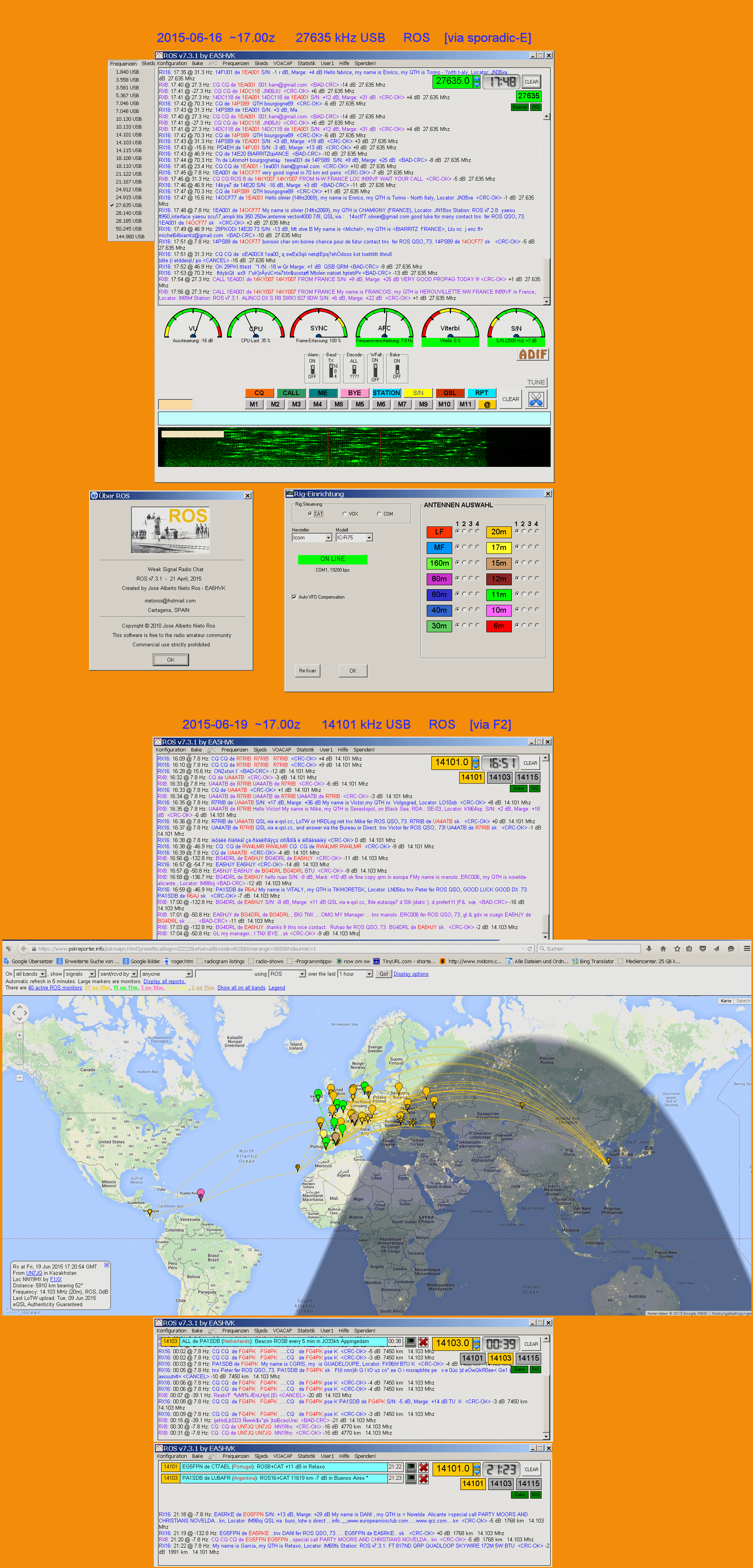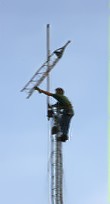www.rhci-online.net/radiogram/radiogram.htm
██╗ ██╗██████╗ ██████╗ ██████╗ █████╗ ██████╗ ██╗ ██████╗ ██████╗ ██████╗ █████╗ ███╗ ███╗
██║ ██╔╝██╔══██╗██╔════╝ ██╔══██╗██╔══██╗██╔══██╗██║██╔═══██╗██╔════╝ ██╔══██╗██╔══██╗████╗ ████║
█████╔╝ ██████╔╝██║ ██████╔╝███████║██║ ██║██║██║ ██║██║ ███╗██████╔╝███████║██╔████╔██║
██╔═██╗ ██╔══██╗██║ ██╔══██╗██╔══██║██║ ██║██║██║ ██║██║ ██║██╔══██╗██╔══██║██║╚██╔╝██║
██║ ██╗██████╔╝╚██████╗ ██║ ██║██║ ██║██████╔╝██║╚██████╔╝╚██████╔╝██║ ██║██║ ██║██║ ╚═╝ ██║
╚═╝ ╚═╝╚═════╝ ╚═════╝ ╚═╝ ╚═╝╚═╝ ╚═╝╚═════╝ ╚═╝ ╚═════╝ ╚═════╝ ╚═╝ ╚═╝╚═╝ ╚═╝╚═╝ ╚═╝
|
http://www.kbcradio.eu/
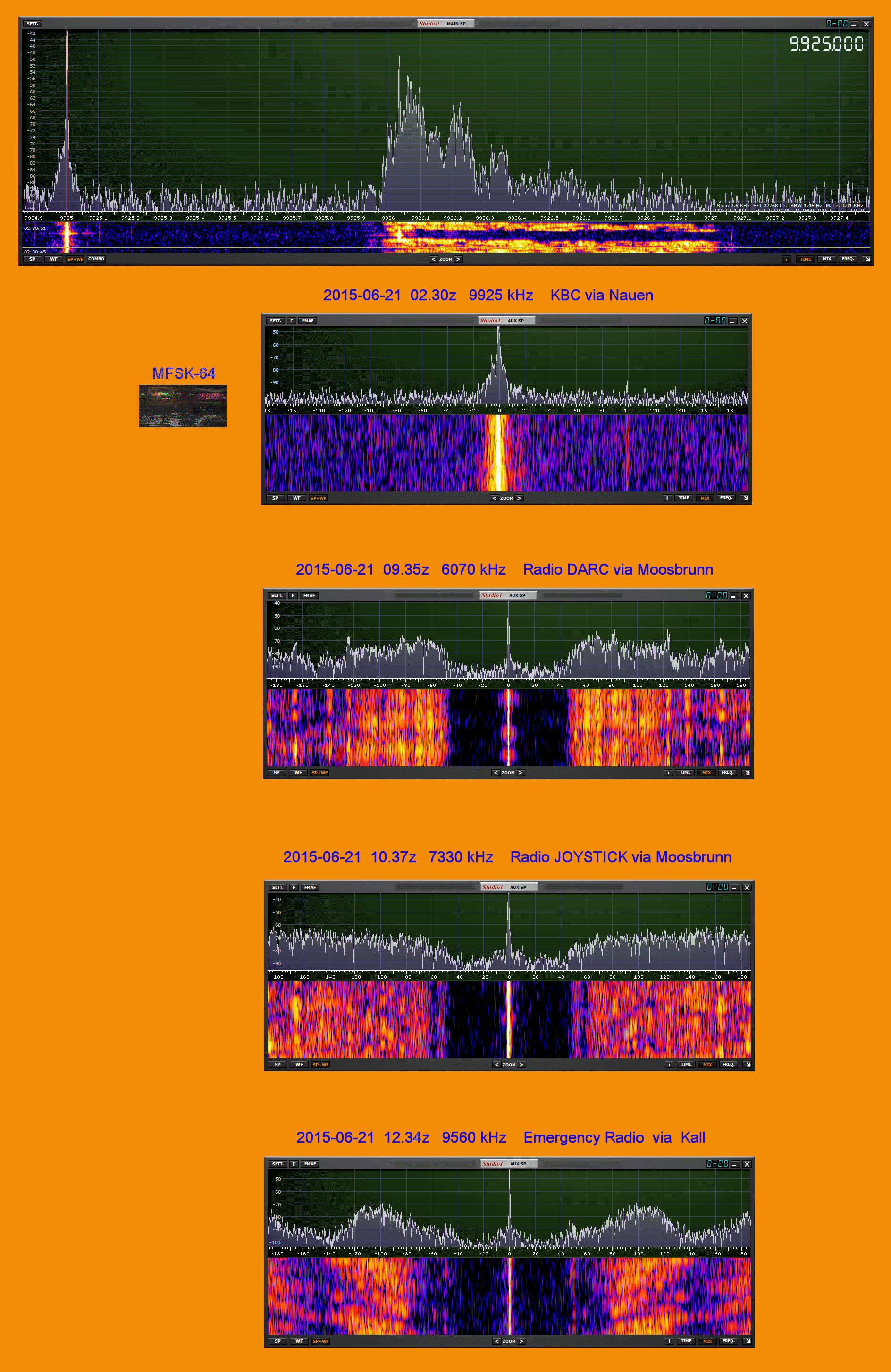
RSID: <<2015-06-21T02:30Z
MFSK-64 @
9925000+1500>>
|
DSB |
Lots of interesting videos of KBC reception at
funebook.com/TheMightyKBC, inte n$te§a tns™
t nt ud?eouiYr0>nUce, using a Realistic DX-302 receiver ...
|
Sending Pic:185x90C; |
 |
|
AM |
Lots of interesting videoaief
KBlNnrion at
facebook.com/TheMi yKBC, including one from Patrick in
southern France, using a Realistic DX-302Baeiiver d ..
|
Sending Pic:185x90C;nh |
 |
|
USB |
Lots of interesting videos of KB
a#Zeadion nt
facebook.com/TheMightyKBCfDY ÈNXq one from Patrick in
southern France, using a Realistic DX-302 receiver ... |
Sending Pic:185x90C; |
 |
|
LSB |
Lots of interesting videos of KBC reception at
facebook.com/TheMight t:cB Îeìi ftwcuj o
Piouthern Hoeo using a Realistic DX-302 receiveU..
|
ding Pic:185x90C; |
 |
|
Twente - AM |
Lots of intereaGug videos of KBC reception at
facebook.com/TheMightyKBC, including one from Patrick in
southern France, using a Realistic DX-302 receiver ... |
Sending Pic:185x90C; |
 |
|
reconstruction |
Lots of interesting videos of KBC
reception at
[DSB+LSB]
facebook.com/TheMightyKBC,
including one from Patrick in [DSB/AM]
southern France, using a
Realistic DX-302 receiver ...
[USB]
|
|
|
|
studio recording |
Lots of interesting videos of KBC
reception at
facebook.com/TheMightyKBC, including one from Patrick in
southern France, using a Realistic DX-302 receiver ... |
Sending Pic:185x90C; |
 |
https://www.facebook.com/patrick.flambard/videos/10206734081688629/
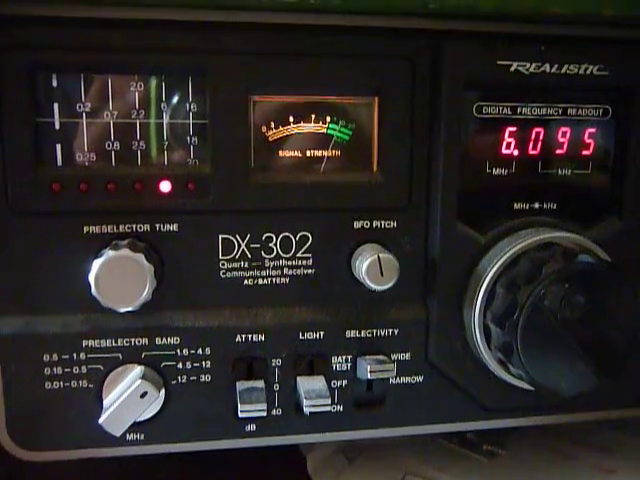
.
███████╗███╗ ███╗███████╗██████╗ ██████╗ ███████╗███╗ ██╗ ██████╗██╗ ██╗ ██████╗ █████╗ ██████╗ ██╗ ██████╗
██╔════╝████╗ ████║██╔════╝██╔══██╗██╔════╝ ██╔════╝████╗ ██║██╔════╝╚██╗ ██╔╝ ██╔══██╗██╔══██╗██╔══██╗██║██╔═══██╗
█████╗ ██╔████╔██║█████╗ ██████╔╝██║ ███╗█████╗ ██╔██╗ ██║██║ ╚████╔╝ ██████╔╝███████║██║ ██║██║██║ ██║
██╔══╝ ██║╚██╔╝██║██╔══╝ ██╔══██╗██║ ██║██╔══╝ ██║╚██╗██║██║ ╚██╔╝ ██╔══██╗██╔══██║██║ ██║██║██║ ██║
███████╗██║ ╚═╝ ██║███████╗██║ ██║╚██████╔╝███████╗██║ ╚████║╚██████╗ ██║ ██║ ██║██║ ██║██████╔╝██║╚██████╔╝
╚══════╝╚═╝ ╚═╝╚══════╝╚═╝ ╚═╝ ╚═════╝ ╚══════╝╚═╝ ╚═══╝ ╚═════╝ ╚═╝ ╚═╝ ╚═╝╚═╝ ╚═╝╚═════╝ ╚═╝ ╚═════╝
http://emergency-radio.net/
|
3985 kHz - Kall |
6005 kHz -
Kall |
7310kHz -
Kall |
9560 kHz -
Kall |
|
sws3985.m3u |
sws6005.m3u |
sws7310.m3u |
sws9560.m3u |
|
|
|
|
|
|
|
|
08.00-08.05z [re-broadcast] |
|
|
|
|
|
|
|
|
|
|
12.30-12.35z [re-broadcast] |
|
|
|
|
|
|
|
17.00-17.05z 1st broadcast |
17.00-17.05z 1st broadcast |
|
|
|
|
|
|
http://www.shortwaveservice.com/empfangen/programmplan/?lang=de
http://shortwaveservice.com/a15.pdf
<<2015-06-20T17:04Z
THOR100 @
6005000+1500>>
<<2015-06-21T08:04Z
THOR100 @
7310000+1500>>
<<2015-06-21T12:34Z
THOR100 @
9560000+1500>>
A DX-pedition is an expedition to what is considered an exotic place by amateur
radio operators, perhaps because of its remoteness or because there are very few
radio amateurs active from that place. This could be an island, a country, or
even a particular spot on a
geographical grid.
The activity was pioneered by one-time ARRL president Robert W. Denniston. Mr.
Denniston's 1948 DX-pedition was to the Bahamas and was called "Gon-Waki" ala
Thor Heyerdahl's "Kon-Tiki" expedition the previous year. Arguably there were
earlier trips where amateur
radio was used that might have qualified as DX-peditions. An example is the
voyage of the schooner Kaimiloa, which traveled the South Pacific in 1924. While
the ship's wealthy owners enjoyed the islands an amateur radio operator kept
contact with, and sent QSL cards
to, experimenters in the United States.[14]
Early DX-peditions were simply exploratory and geographical expeditions in the
late 1920s and 1930s, in which one or more radio amateurs participated in order
to provide long distance communications. At the same time they communicated with
fellow radio amateurs who
wanted to contact a new country.[1][2] Most notable are the Antarctic
expeditions of Admiral Byrd.[3] Another example is the voyage of the schooner
Kaimiloa, which traveled the South Pacific in 1924. While the ship's wealthy
owners enjoyed the islands, an amateur
radio operator kept contact with, and sent QSL cards to, experimenters in the
United States.[4]
The participation of radio amateurs in geographical expeditions was resumed
after World War II, e.g. the participation of Bob Leo, W6PBV, in the
Gatti-Hallicrafters expedition in Africa of 1948.[1] The most unusual expedition
to place reliance on amateur radio for
communications was that of Kon-Tiki organized by Thor Heyerdahl in 1947 and
using call sign LI2B.[5]
The activity of dedicated DX-peditions was pioneered by one-time ARRL president
Robert W. Denniston, W0DX. Mr. Denniston's 1948 DX-pedition, using call sign
VP7NG, was to the Bahamas and was called "Gon-Waki" ala Thor Heyerdahl's "Kon-Tiki"
expedition the previous
year.[6]
de PA0ETE k
<<2015-06-21T17:04Z
THOR50x1 @
7310000+1500>>
This time it is THOR 50x 1, 50 x 1 around 1500 Hz again. Help needed to receive
NanosatC-BR1. The first Brazilian CubeSat, NanosatC-BR1, has been experiencing
battery issues.
de PA0ETE k
<<2015-06-22T17:04Z
THOR50x1 @
7310000+1000>>
Poor
conditions,
but
LSB or USB worked
100%
-
with
S-AM, AM,
or DSB only
50% of all
characters could be decoded.
MFSK is similar to the commercial Piccolo system. MFSK is very good under poor
propagation conditions. The usual variant of MFSK is MFSK 16, but other types
such as MFSK 8 are in development, along with other similar modes to MFSK (such
as Domino).
de PA0ETE k
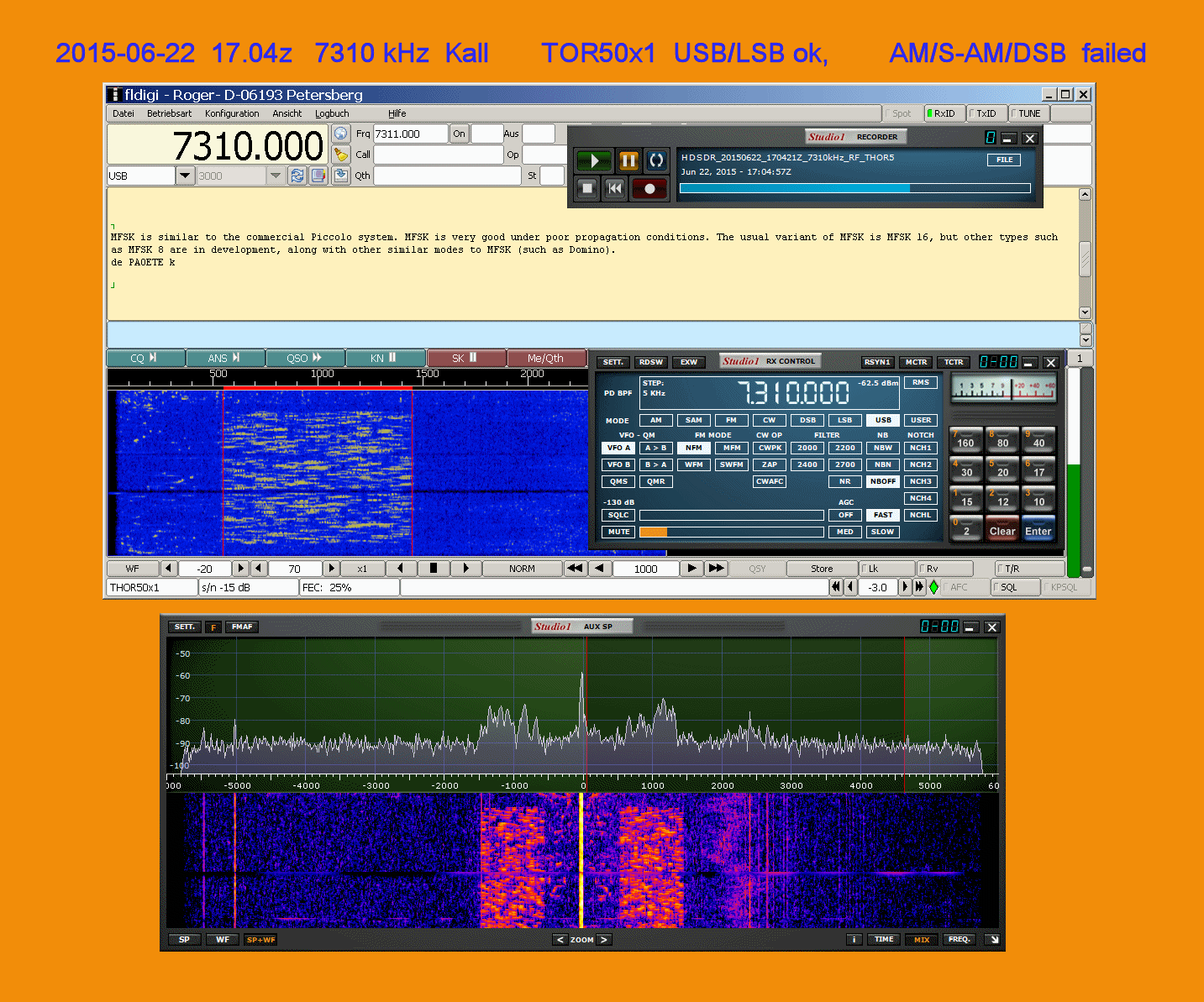
<<2015-06-23T17:04Z
HELLX5 @
6005000+1500>>
Geomagnetic storm -
bad conditions for 7310 + 6005 kHz, signal fade out.
I
had to use the internet
as emergency connection
for the
"emergency-radio"
program..............
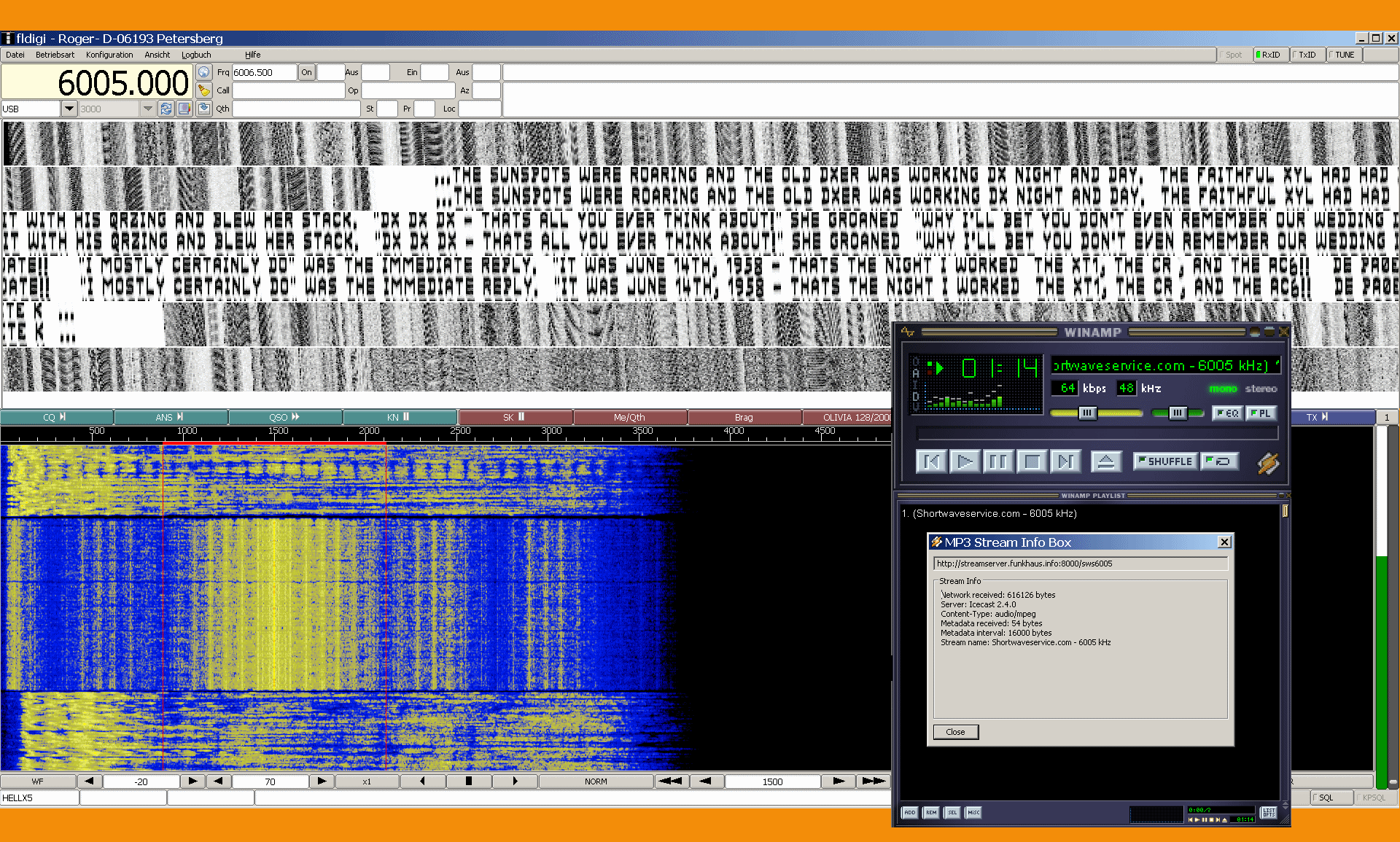
<<2015-06-25T17:04Z
THOR50x2 @
6005000+1500>>
<STX>
[WRAP:beg][WRAP:lf][WRAP:fn
Fox-hunt-moxon_PA5TYS_PA3FYM_128-lo.jpg][b64:start]AUxaTUEAAAmNXQAAAAQAPhfuAIcRlWpv2bS9wZxHapj+EHJ+a3GwtB+BOFQ7vBUgk9bUzYFL
TyEp0wa8+efIIZN5BJdKggCF83kQgpPp7zl8Vlw1Grlf4ZkOVCoM3duMISobjjJfU9Dxtca7
igUcEnm68VDmkI/AGYERa5XxTNQ+Qv/UVkWhu6qSLgoC/91xsEE+xITGTUxz9k8dLtaDyOAB
JaePf7o27wiRVyd/w4HCoGQzHoHomsUMXdlGQBLqSjmY8c0ZSJwRo681QlHf/gsMiefVl8j0
ZYXYJgfPigQYMov9lgAJKtyYKHGRN8tpZnEY5sMF5qUCIvEAlXTSY2t14I8xvuHzzRb8pdQv
V7gNu/89wFCkUCU06ES6C7joqBm3zXtKOLC4xN3YsqZ1+sY1gOiSQtlxwEtJAHFeeqEEk3rx
Ms3whxcdgyW1UB82YULHDcOMfbvDr2hGnQ+0oNambTWKHP8DQjPrNxlsap3S5yW08u6kH8Bn
4ulc8HSIXow/BoW19gDTL8yJZxZ2CNGNKVr6OhETvGsq6Uo15UkqI5q2aJL0XXr/imYJglXR
rTklRqKKRupI+xtUEgqfZAOBZUsTofhhuAzfhJb5KQuSPE+646AIMLlU5qD5HPzGEcxHbXUd
QM6ZOJ4c122X46bEWHWpCSykQNWBiGnbI+mJ1GHPerHER6P0Y/RGX3ByZGZ88S0n/SGblpb9
gC+QjAfWwIdvG8BDxFE21uvz6jJIDaOB9P79SrWkgfgQxX/Zv9lo3QWyUmo/NWo+gObK6dHr
7MqWncwXRnz+qt1LFLF+bF97orLk51BNR8+0HI/of1EkyUKnNexr5VwFMV6zfZrCcbSaXvYo
aO5eSIx2MsaFVNqWYpbEwQ9slbrgQZfGa5BQEcLkNAYiy1an3vs/d5VoimHKaeQvQDnAKchq
UfoeLM/5bwqAuUNBift3/gd9uUhrey7QV/Uk+X8kKRyA237ac+es2WLLD1S3Q11RrW/gC6bI
LfaRtd5uu28mvq+RRmUQecufcoMWK1SqhGKRujpA2ADYbE/+HhzFkrITztrGNFtMwx7X5DqA
aoeFxNanlpUe2ttrX6SiWeJ3Gi/U7Bl4aq3NlzfyXMR21iNjuAR+wGgnJrbHue01Cl3mPfKW
w3YakBc6u7dw8B+UvqkSBF7cYIIlJr33to3MBtPrS2JiiFUCf0BsbyVH8sPzDBmc8qSuOnha
fNATLCsXfQ8peLB8kIsUgGkR3YbdLUVciYk2ORyKh5vk4voYezVzFjiox2iXeYkGGQUKJ/eK
gNqDpanpcS1e8I+eKZRAOwoGgFrBgWaVg2VYtw1L6Pjv+nBBxo7cTQHZLTPyAMv78KUfs20O
MnK5gAdyChsHbFudPAA=
[b64:end][WRAP:chksum 2D3A][WRAP:end]
de PA0ETE k
<EOT>
WRAP/b64 ==>
Fox-hunt-moxon_PA5TYS_PA3FYM_128-lo.jpg

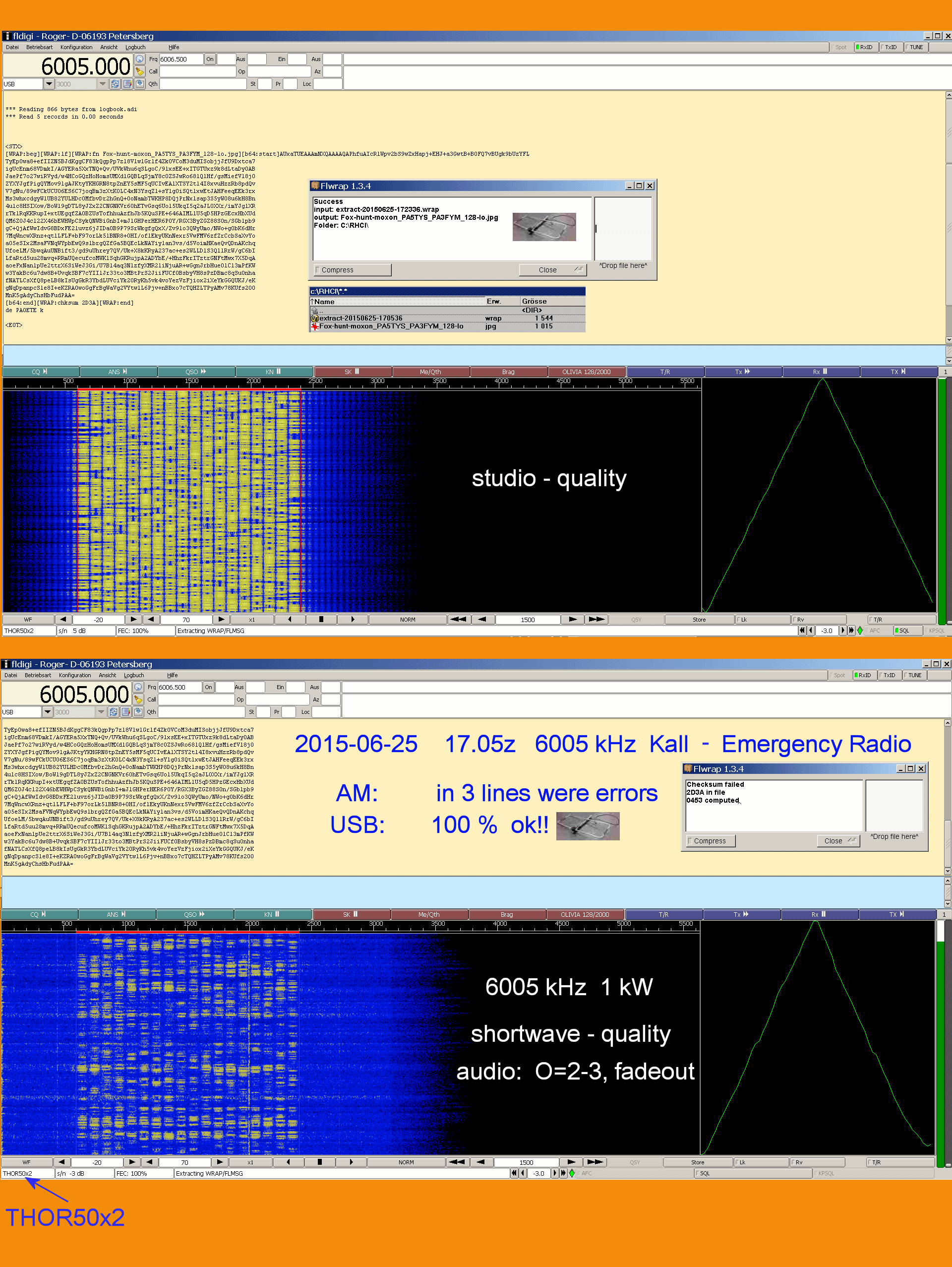
██╗ ██╗ ██████╗ █████╗ ██████╗ █████╗ ██████╗ ██╗ ██████╗ ██████╗ ██████╗ █████╗ ███╗ ███╗
██║ ██║██╔═══██╗██╔══██╗ ██╔══██╗██╔══██╗██╔══██╗██║██╔═══██╗██╔════╝ ██╔══██╗██╔══██╗████╗ ████║
██║ ██║██║ ██║███████║ ██████╔╝███████║██║ ██║██║██║ ██║██║ ███╗██████╔╝███████║██╔████╔██║
╚██╗ ██╔╝██║ ██║██╔══██║ ██╔══██╗██╔══██║██║ ██║██║██║ ██║██║ ██║██╔══██╗██╔══██║██║╚██╔╝██║
╚████╔╝ ╚██████╔╝██║ ██║ ██║ ██║██║ ██║██████╔╝██║╚██████╔╝╚██████╔╝██║ ██║██║ ██║██║ ╚═╝ ██║
╚═══╝ ╚═════╝ ╚═╝ ╚═╝ ╚═╝ ╚═╝╚═╝ ╚═╝╚═════╝ ╚═╝ ╚═════╝ ╚═════╝ ╚═╝ ╚═╝╚═╝ ╚═╝╚═╝ ╚═╝
http://voaradiogram.net/
RSID: <<2015-06-20T16:02Z
MFSK-32 @ 17870000+1500>>
Welcome to program 116 of VOA Radiogram from the Voice of
America.
I'm Kim Andrew Elliott in Washington.
Here is the lineup for today's program, all in MFSK32 except
where noted:
1:32 Program preview (now)
2:51 Amateur Radio Field Day at former VOA
transmitting site*
9:38 630M medium wave transmissions on Field Day
12:52 Watermills in Pakistan generate electricity*
20:26 Myanmar intensifies media restrictions*
26:42 MFSK32: Closing announcements
27:43 MFSK16: Bonus mode 16 dB under closing music
28:40 MFSK16: At full level
* with image
Please send reception reports to radiogram@voanews.com.
And visit voaradiogram.net.
Twitter: @VOARadiogram
Kim's note: The following press release is from the National
Voice of America Museum of Broadcasting, which is located at the
site of the old VOA shortwave transmitting station at Bethany,
Ohio, near Cincinnati ...
West Chester, Ohio, Hams to participate in Field Day June 27-28
National Voice of America Museum of Broadcasting press release
June 16, 2015
West Chester amateur radio fans are just a bunch of
"hams" -- literally as well as figuratively.
The West Chester Amateur Radio Association (WCARA) will show off
to the public its expertise providing critical communication
during emergencies on June 27-28 on the front lawn of the
historic, art deco National Voice of America Museum of
Broadcasting.
The 50-member group will join about 30,000 ham radio operators
nationwide for the American Radio Relay League's (ARRL) annual
Field Day. Its purpose is to provide a comprenhensive evaluation
of our nation's emergency radio capabilities as well as inspire a
new generation of ham radio operators. Admission is free.
"We want people to come, bring their families and see that this
is not your grandfather's radio anymore," said John Graves, vice
president of WCARA. "We have a good time while doing interesting
and serious work. The communications networks that ham radio
operators can quickly create have saved many lives in the past,
when other systems failed or were overloaded."
West Chester hams will demonstrate the capability of local
amateur radio operators to conduct emergency radio communications
off the power grid for an extended period of time and show how
to send messages in many forms without the use of phone systems,
internet or any other infrastructure that can be compromised in a
crisis.
Over the past year, the news has been full of reports of ham
radio operators providing critical communications in emergencies
including the California wildfires, Oregon and Michigan storms,
tornadoes and other events world-wide, according to an ARRL news
release. During Hurricane Katrina in 2005, amateur radio
communication was often the only way people could communicate and
hundreds of volunteer hams traveled south to save lives and
property, said the release.
"It's important to understand that our current mobile technology
is wonderful when it works," said Jack Dominic, executive
director of the National VOA Museum of Broadcasting. "The fact is
that for it to work requires countless devices and circuits.
Even a simple phone call across town will route your conversation
in such a way that it will pass hundreds of points of potential
failure. Most of the time all works flawlessly, but during storms
or other disasters, we have already seen that it can fail. The
simple point-to-point amateur radio communication is something we
just might want to keep around. The time will certainly come when
we will need it."
Field Day testing begins Saturday, June 27 at 2 p.m. [1800 UTC]
and runs continuously for 24 hours until Sunday, June 28 at 2
p.m. Visitors who approach the trailers and tents in front of the
VOA museum building at 8070 Tylersville Road can learn how to
operate a radio station and get their own FCC radio license
before the next disaster strikes, said Graves.
WCARA operates radio station WC8VOA from the VOA museum building.
To learn more about local amateur radio, go to www.wc8voa.org or
contact Graves at jmgraves@fuse.net.
http://www.voamuseum.org/about/news/arrl-fiedl-day-2015/
Image: Mike Murphy, KA8ABR, adjusts the top of a radio antenna on
the campus of the National VOA Museum of Broadcasting ...
Medium-Wave Experimenters to Transmit Field Day Greetings
American Radio Relay League press release
June 15, 2015
Once again this year a group of medium-wave experimental
licensees will transmit greetings on 630 meters over the ARRL
Field Day weekend, June 27-28. While the 472 to 479 kHz band is
not yet available for Amateur Radio use, John Langridge, KB5NJD,
said he’d like to continue promoting awareness of the proposed
ham band. In April, the FCC proposed a new 630 meter Amateur
Service MW allocation at 472 to 479 kHz, and it allocated a new
LF band, 135.7 to 137.8 kHz — both on a secondary basis.
Langridge this year is hoping that some LF experimenters also
will take part in the exercise. No Amateur Radio operation will
be permitted in either band until the FCC establishes specific
operating rules.
ARRL 600 Meter Experimental Group (WD2XSH) Coordinator Fritz
Raab, W1FR, said the FCC's April Report and Order, Order, and
Notice of Proposed Rulemaking is a step in the right direction,
and he hopes it will eventually lead to a new 630 meter amateur
band in the US. "However, it's a huge document, so we expect it
to take a while for any of the proposed changes to be
implemented," he told ARRL. "With that in mind, we plan to renew
the WD2XSH license and continue operations much as we have been
until such time as the 630 meter band becomes a reality."
Some of the stations involved in the Field Day activity,
including Langridge, are participants in the ARRL experiment.
Langridge said last year he got about 60 reports from his own
transmissions from Texas. ...
Langridge said Field Day stations could try using an HF
transceiver capable covering the 472-479 kHz range to listen for
participating stations. He stressed that stations use “whatever
antennas that they have on site — a dipole, a tribander, a
vertical, whatever — as the impedance mismatch may help improve
the signal-to-noise ratio enough for effective copy.”
Full text:
http://www.arrl.org/news/medium-wave-experimenters-to-transmit-field-day-greetings
This is VOA Radiogram from the Voice of America.
Please send reception reports to radiogram@voanews.com.
VOA NEWS
Pakistan Electrical Innovation Revisits Old Technology
Ayaz Gul
June 16, 2015
ISLAMABAD - In energy-starved Pakistan, the government is focused
on building complex, multi-billion-dollar power stations to meet
the demand for electricity.
But one entrepreneur in a small village in the
Pakistan-administered Kashmir region has a much simpler, cheaper
solution that could help many in this mountainous region.
Ashiq Hussain Kazmi owns a watermill, locally known as "jandar,"
that for six decades has been grinding grain to feed people in
Bagh Syedan village, 20 kilometers from the regional capital,
Muzafarabad.
Kazmi said the mill needs a major overhaul, especially after the
October 2005 earthquake. "The mechanical system installed here is
very old and needs to be replaced to improve performance. The
earthquake also damaged parts of its foundation but we are
running it because it is simply not possible for us to get it
repaired," he said.
Like many places in Pakistan, Kazmi said that his village and
surrounding settlements are plunged into darkness after sunset
because of the government's plan to not overtax the weak
electrical grid. Many rely on candles and wood to light their
houses and cook food.
Electrical appliances, particularly television sets and
refrigerators have been switched off permanently. Villagers
sometimes cannot charge the batteries of their cell phones to
stay in contact with relatives.
With no hope from the political leadership to provide immediate
relief, Kazmi looked to his aging watermill for a solution.
Using recycled materials
He traveled to the city to purchase used equipment and recycled
copper wires from a scrapyard. Over time, he succeeded in
converting the mill into an electricity generator for less than
$100.
"The 3.5-kilowatt turbine produces enough electricity to light
eight houses of our family, Kazmi said. "Adding they could
finally turn on their TVs and charge cell phone batteries while
one refrigerator is also running on the power being generator."
"If the government cooperates and a bigger turbine of around 7.5
kilowatts is placed here, we can supply electricity to not only
our entire village of 800 people but also to the neighboring
settlements," he added.
There are hundreds of watermills in the poverty-stricken Kashmir
region, but Kazmi is one of only a few who could afford the
conversion costs to become power generators.
Government's plan to invest
Regional Planning chief Mansoor Qadir Dar said the government is
now looking into providing funds for such projects, but admits
the administration has only recently come to know about the
untapped energy potential that watermills offer.
"They [mill owners] have to send us the resolution that the mill
is available and water is there and we need such and such
technical and financial support, we will give them that financial
support and we have also funds earmarked for this particular
facility," Dar claimed.
Prime Minister Nawaz Sharif's government has vowed to resolve the
electricity crisis by 2018, when several proposed energy
mega-projects will be completed and begin adding thousands of new
megawatts of power to the national grid.
Pakistan faces an annual electricity shortfall of around 4,500
megawatts in the peak summer months of June and July.
http://www.voanews.com/content/pakistan-electrical-innovation-finding-new-solution-in-old-technology/2824314.html
Image: Ashiq Hussain Kazmi's watermill ...
Sending Pic:245x144C;
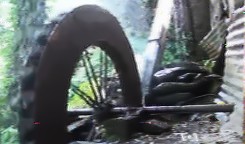
This is VOA Radiogram from the Voice of America.
Please send reception reports to radiogram@voanews.com.
VOA NEWS
Myanmar Seen Intensifying Media Intimidation Ahead of Elections
Steve Herman, W7VOA
June 16, 2015
BANGKOK - Myanmar's authorities are intensifying restrictions on
media as the country approaches critical national elections,
using threats, harassment and imprisonment to stifle independent
journalists and outlets, according to an Amnesty International
report released Wednesday.
"Journalists play such a crucial role around elections. They can
help improve access to information, help people understand the
choices they have to make," Rupert Abbott, Amnesty's research
director for Southeast Asia, told VOA. "The role of journalists,
the role of freedom of expression around elections, really is
crucial."
At least 10 Myanmar media workers are in prison, all of them
jailed in the last 12 months, according to the report.
Lines not to be crossed
Journalists in the Southeast Asian country, according to the
report, are well aware there are "red lines" they cannot cross,
including stories related to the powerful military, Buddhist
extremists and the plight of the minority Rohingya, which the
government will refer to only as Bengalis. In 2014, freelance
reporter Aung Kyaw Naing was killed while in military custody
after covering fighting between the Burmese army and ethnic Karen
fighters.
Amnesty says such incidents mean a climate of fear persists for
journalists in the country.
Some journalists, who are quoted in the report anonymously
because of fear of reprisals, said military personnel had
threatened to assault them or throw them in jail while they were
covering issues related to the army, such as armed conflict in
ethnic areas.
"They're self-censoring," said Abbott. "To directly quote some of
those we interviewed, they're 'walking a fine line.' They risk
being taken to court anytime. And, also, they're concerned that
information could be used against them if the political situation
changes again."
History of censorship
Myanmar's media, since a 1962 military coup, spent decades under
tight censorship that extended to films and even poetry. Reforms
since 2011 have led to a lifting of bans on international news
websites and prepublication censorship. Privately owned
newspapers have also been permitted. But the state retains
controls of the main broadcasters and publications.
VOA's Burmese service television and radio newscasts are not
blocked, and the language service has a bureau in Yangon.
Myanmar's Information Minister Ye Htut in recent months has
defended the country's loosening of censorship laws once
considered among the world's most restrictive. He has told
reporters that Myanmar has experienced both positive and negative
developments in recent years, which has shown that the government
needs to work with the international news media.
He also said further reforms of policies governing the news media
are not likely until after national elections, which are expected
around November.
http://www.voanews.com/content/myanmar-seen-intensifying-media-intimidation/2825630.html
See also:
https://www.amnesty.org/en/latest/news/2015/06/myanmars-media-stifled-by-climate-of-fear/
Image: Photo of VOA's Steve Herman from his Twitter account,
@W7VOA ...
Sending Pic:129x128C;
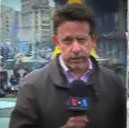
Please send reception reports to radiogram@voanews.com.
And visit voaradiogram.net.
Twitter: @VOARadiogram
Thanks to colleagues at the Edward R. Murrow shortwave
transmitting station in North Carolina.
I'm Kim Elliott. Please join us for the next VOA Radiogram.
This is VOA, the Voice of America.
RSID: <<2015-06-20T16:28Z
MFSK-16 @ 17870000+1500>>
MFSK-16
16 dB under
closing music
VOA Radiogram transmission schedule
(Days/times UTC):
Sat 0930-1000 5745 kHz
Sat 1600-1630 17870 kHz
Sun 0230-0300 5745 kHz
Sun 1930-2000 15670 kHz
All via North Carolina
RSID: <<2015-06-20T16:29Z
MFSK-16 @ 17870000+1500>>
Thank you for decoding the modes on VOA Radiogram.
www.rhci-online.net/radiogram/radiogram.htm
|
QTH: |
D-06193 Petersberg
(Germany/Germania) |
|
Ant.: |
Dipol for
40m-Band
& Boomerang Antenna 11m-Band |
|
RX
for RF: |
FRG-100B
+ IF-mixer &
ICOM IC-R75 + IF-mixer |
|
Software IF: |
con
STUDIO1 - Software italiano per SDR
[S-AM-USB/LSB] |
|
Software AF: |
Fldigi-3.22.10 +
flmsg-2.0.8 |
|
OS: |
German XP-SP3 with support for
asian languages |
German W7 32bit +
64bit |
|
PC:
|
MEDION
Titanium 8008 (since 2003) [ P4 - 2,6 GHz]
|
MSI-CR70-2MP345W7
(since2014) [i5 -P3560
( 2 x 2,6GHz)
] |
ROS - WEAK SIGNALS SOFTWARE
https://rosmodem.wordpress.com/
